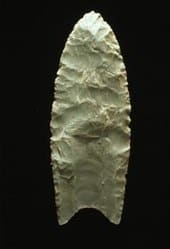
Clovis culture
The Clovis culture is a prehistoric Paleoamerican culture, named for distinct stone tools found in close association with Pleistocene fauna at Blackwater Locality No. 1 near Clovis, New Mexico in the 1920s and 1930s. It appears around 11,500–11,000 uncalibrated RCYBP at the end of the last glacial period, and is characterized by the manufacture of “Clovis points” and distinctive bone and ivory tools. Archaeologists’ most precise determinations at present suggest this radiocarbon age is equal to roughly 13,200 to 12,900 calendar years ago. Clovis people are considered to be the ancestors of most of the indigenous peoples of the Americas.The only human burial that has been directly associated with tools from the Clovis culture included the remains of an infant boy researchers named Anzick-1. Paleogenetic analyses of Anzick-1’s ancient nuclear, mitochondrial, and Y-chromosome DNA reveal that Anzick-1 is closely related to modern Native American populations, which lends support to the Beringia hypothesis for the settlement of the Americas.The Clovis culture was replaced by several more localized regional societies from the Younger Dryas cold-climate period onward. Post-Clovis cultures include the Folsom tradition, Gainey, Suwannee-Simpson, Plainview-Goshen, Cumberland, and Redstone. Each of these is thought to derive directly from Clovis, in some cases apparently differing only in the length of the fluting on their projectile points.
Read More About Clovis culture
